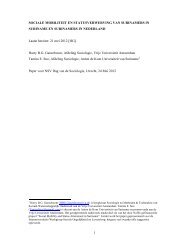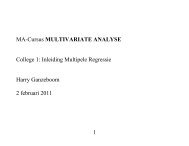Subjective measures of social status - harry ganzeboom's home page
Subjective measures of social status - harry ganzeboom's home page
Subjective measures of social status - harry ganzeboom's home page
You also want an ePaper? Increase the reach of your titles
YUMPU automatically turns print PDFs into web optimized ePapers that Google loves.
<strong>Subjective</strong> <strong>measures</strong> <strong>of</strong> <strong>social</strong><strong>status</strong>: validationHarry B.G. GanzeboomFree University AmsterdamISSP, Taipei, April 29 2007Three <strong>measures</strong> <strong>of</strong> subjective<strong>social</strong> <strong>status</strong>• Centers (1949): <strong>Subjective</strong> 'Social Class (lowerclass, working class, upper working class, middleclass, upper middle class, upper class).• Diagram question: "Where do you belong indiagram?" (1 – top … 6 – bottom).• Top-bottom ladder: "Where would you putyourself on this scale?" (1 – top … 10 – bottom).<strong>Subjective</strong> <strong>social</strong> <strong>status</strong> in ISSP 1<strong>Subjective</strong> <strong>social</strong> <strong>status</strong> in ISSP 2Questions• Do they measure the same thing (validity)?• Do they measure that same thing with equalreliability?• Do we need three indicators: what is thatgood for?Research design• Compare distributions across country andtime:– R2 by country– Change in means over time• Missing value patterns• Reliability / factoi analysis• Validity analysis in structural model<strong>Subjective</strong> <strong>social</strong> <strong>status</strong> in ISSP 3<strong>Subjective</strong> <strong>social</strong> <strong>status</strong> in ISSP 4EducationStructural modelMeasurement modelSUBJECTIVESTATUSOccupationSUBJECTIVESTATUSYIncomeclass diafit topbot<strong>Subjective</strong> <strong>social</strong> <strong>status</strong> in ISSP 5<strong>Subjective</strong> <strong>social</strong> <strong>status</strong> in ISSP 6
Data (from INEQ modules)Missing values analysis• Distributional analysis: all available data.• Validation: only countries/wave in which allthree <strong>measures</strong> are available–Pooled– Per country/wave19871992CLASS2.910.6DIAFIT16.7TOPBOT3.63.219994.56.83.3<strong>Subjective</strong> <strong>social</strong> <strong>status</strong> in ISSP 7<strong>Subjective</strong> <strong>social</strong> <strong>status</strong> in ISSP 8Correlations – all dataCorrelations -- listwiseCorrelationsCorrelationsTOPBOTCLASSDIAFIT1Pearson CorrelationSig. (2-tailed)NPearson CorrelationSig. (2-tailed)NPearson CorrelationSig. (2-tailed)NTOPBOT CLASS DIAFIT11 .487 .651. .000 .00070613 56537 37996.487 1 .508.000 . .00056537 58141 36925.651 .508 1.000 .000 .37996 36925 38880TOPBOTCLASSDIAFIT1Pearson CorrelationSig. (2-tailed)NPearson CorrelationSig. (2-tailed)NPearson CorrelationSig. (2-tailed)NTOPBOT CLASS DIAFIT11 .511 .650. .000 .00036145 36145 36145.511 1 .510.000 . .00036145 36145 36145.650 .510 1.000 .000 .36145 36145 36145<strong>Subjective</strong> <strong>social</strong> <strong>status</strong> in ISSP 9<strong>Subjective</strong> <strong>social</strong> <strong>status</strong> in ISSP 10Reliability• Alpha: 0.767• Without CLASS: 0.744• Without DIAFIT1: 0.675• Without TOPBOT: 0.630Differences and trends• TOPBOT 18.7% wave: ns• DIAFIT1 14.2% wave: t = -2.1• CLASS 13.6% wave: t = +2.5<strong>Subjective</strong> <strong>social</strong> <strong>status</strong> in ISSP 11<strong>Subjective</strong> <strong>social</strong> <strong>status</strong> in ISSP 12
Predicting TOLARGECorrelations with objective <strong>status</strong>[1] [2]• CLASS .139 .079• DIAFIT1 .144 .104• TOPBOT .089 .072• SUBJPOS .214 .214CLASSDIAFIT1EDUC-ATION.231.161OCCUP-ATION.226.158INCOME.145.198(Standardized regression coefficients, controlled for countryand wave differences, [1]: bivariate, [2] multiple.)TOPBOT.130.141.184<strong>Subjective</strong> <strong>social</strong> <strong>status</strong> in ISSP 13<strong>Subjective</strong> <strong>social</strong> <strong>status</strong> in ISSP 14Intervening variable SES TOLARGE?Total effectControllingCLASSControllingDIAFIT1ControllingTOPBOTControllingSUBJPOS.101.046.061.062.034.149.181.167.218Observe• Effect <strong>of</strong> subjective position is considerablystronger than <strong>of</strong> objective position.• Three indicators are needed to bring out theintervening effect.<strong>Subjective</strong> <strong>social</strong> <strong>status</strong> in ISSP 15<strong>Subjective</strong> <strong>social</strong> <strong>status</strong> in ISSP 16



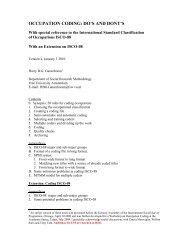
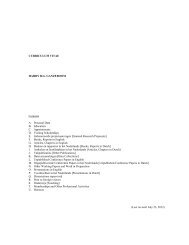
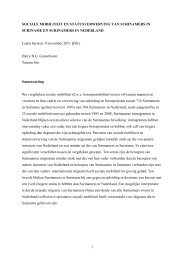
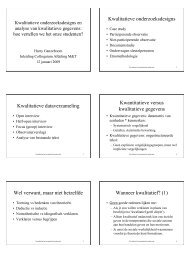
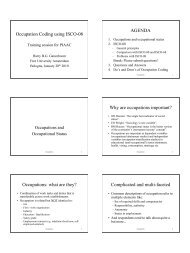
![[SEM] Structural Equation Modeling - Akela](https://img.yumpu.com/31746674/1/177x260/sem-structural-equation-modeling-akela.jpg?quality=85)
